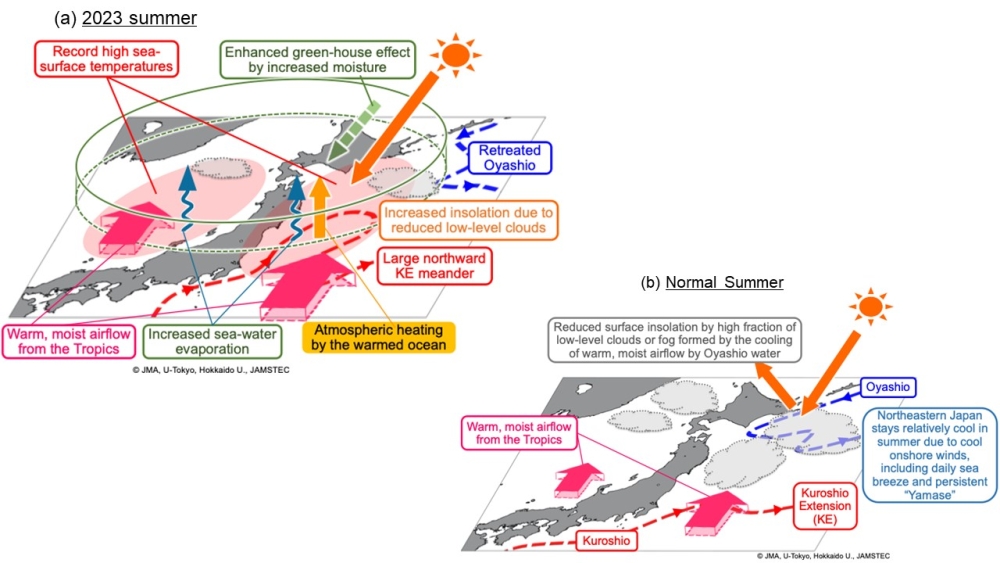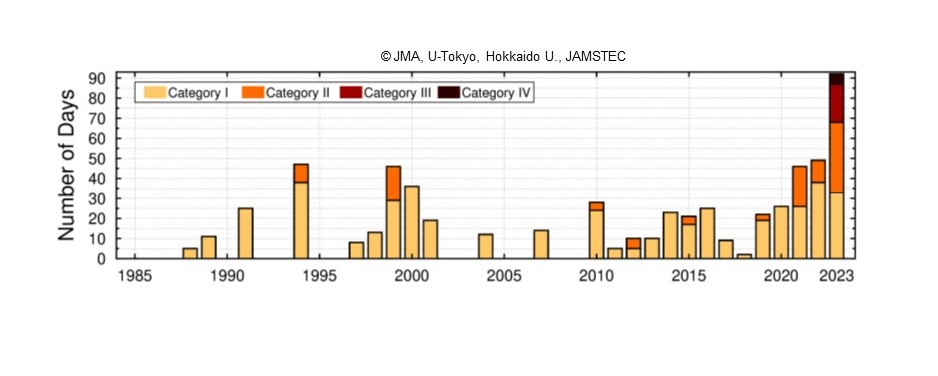- HOME
- NEWS
- RCAST Report
- In hot water : the reasons for northern Japan’s brutal heat in summer 2023
In hot water : the reasons for northern Japan’s brutal heat in summer 2023
- Research News
August 8, 2024
The Research Center for Advanced Science and Technology, The University of Tokyo, reveals why northern Japan may not always be an option for escaping summer heat
Summer 2023 was the hottest ever recorded in northern Japan, and future summers will likely be hotter still. Now, researchers have found that unusually hot seas surrounding northern Japan might be to blame for the area’s record-breaking heat (Fig. 1).
In a study published recently in Scientific Reports, a multi-institutional research team, including the Research Center for Advanced Science and Technology (RCAST), The University of Tokyo, Japan Meteorological Agency (JMA), Hokkaido University and Japan Agency for Marine-Earth Science and Technology (JAMSTEC), has identified how abnormally high ocean temperatures, known as a marine heatwave (MHW), were instrumental in causing 2023’s scathing summer heat (Fig. 2a).
The development of MHWs depends on ocean dynamics, air–sea interactions, and large-scale atmospheric teleconnections such as remote influence of El Niño; when they occur, they can devastate marine ecosystems and cause abnormal weather conditions. Research has revealed that the frequency of MHWs has increased recently (Fig. 3), and it is expected that this trend will continue under global warming.
“The MHW in 2023 was exceptional in terms of its duration and intensity,” says lead author of the study Hirotaka Sato (JMA). “The event off the east coast of northern Japan was classified as severe or extreme in terms of intensity, and its duration of around 90 days was the longest since 1985 (Fig. 3).”
This extreme MHW off the east coast of northern Japan was associated with an unusual northward meander of the warm Kuroshio Extension Current (Fig. 2c), which led to record high surface and subsurface water temperatures that persisted throughout the summer (Fig. 2b). The elevated water temperatures affected the overlying atmosphere by preventing the formation of low-level clouds, which increased the amount of solar radiation and resulted in further heating of the surface water (Fig. 1a).
“The impact of positive feedback mechanisms was crucial,” explains Hisashi Nakamura (RCAST), senior author. “Reduced low-level cloud cover, positive cloud radiative feedback, enhanced evaporation and increased moisture in the lower troposphere all contributed to the maintenance of the MHW and influenced the atmospheric heatwave over northern Japan.”
Of particular importance was the link between the additional heating of the atmosphere by the ocean and enhanced evaporation of seawater, which increased the amount of atmospheric water vapor (Fig. 1a).
“Water vapor is a greenhouse gas,” continues Sato, “and among the complex ocean–atmosphere interactions that occur during MHWs, this intensification of the greenhouse effect directly impacted the atmospheric heatwave over northern Japan in summer 2023.”
Given the current trend of global warming, the intensity and frequency of MHWs will continue to increase in the future. The team’s research, which identifies the mechanisms that trigger and sustain MHWs and atmospheric heatwaves, can help us to better predict future extreme heatwaves and mitigate their effects.

-
Figure 1. (a) Schematic of processes involved in the impact of an unprecedented marine heatwave (MHW) on record-breaking hot summer in 2023 over northern Japan. (b) As in (a), but for atmospheric and oceanic processes that characterize climatological summertime situation around northern Japan. Based on Sato et al. (2024 Scientific Reports).

-
Figure 2. (a) Summer-mean surface air temperature anomalies over Japan in 2023. (b) As in (a), but for sea surface temperature anomalies. (c) As in (a), but for ocean current velocity (arrows) and speed (colored) at 100-m depth. Taken from Sato et al. (2024 Scientific Reports).

-
Figure 3. Number of days of individual MHW categories I (modest), II (strong), III (severe) and IV (extreme) in each summer (June-July-August) from 1985. Taken from Sato et al. (2024 Scientific Reports).
【Paper】
- Author:
- Hirotaka Sato, Kazuto Takemura, Akira Ito, Takafumi Umeda, Shuhei Maeda, Youichi Tanimoto, Masami Nonaka & Hisashi Nakamura
- Title:
- Impact of an unprecedented marine heatwave on extremely hot summer over northern Japan in 2023
- Journal:
- Scientific Reports
- Publication Date:
- 2024/7/19
- DOI:
- 10.1038/s41598-024-65291-y

【Research Contact】
Hisashi Nakamura, Professor
Tags

